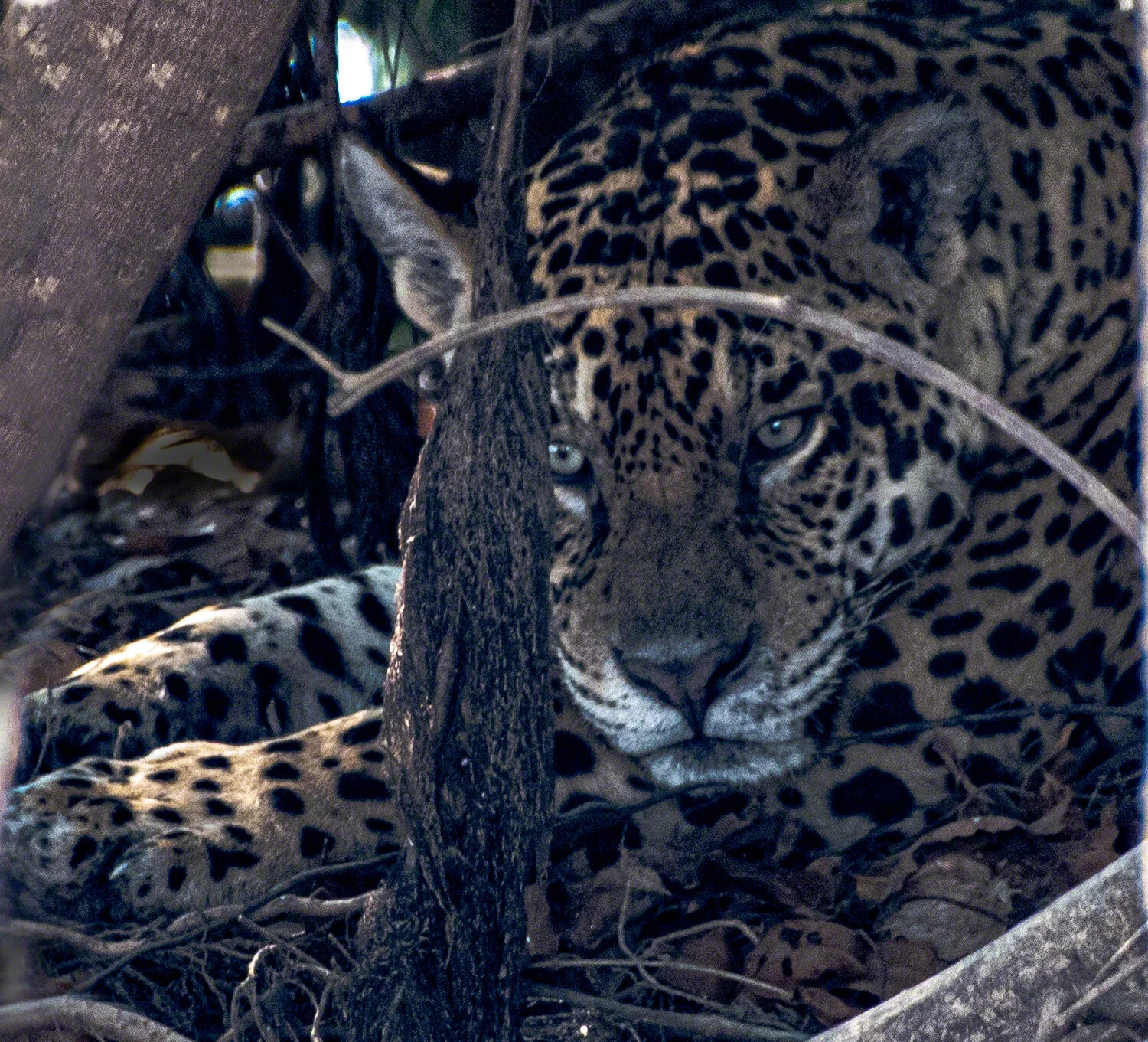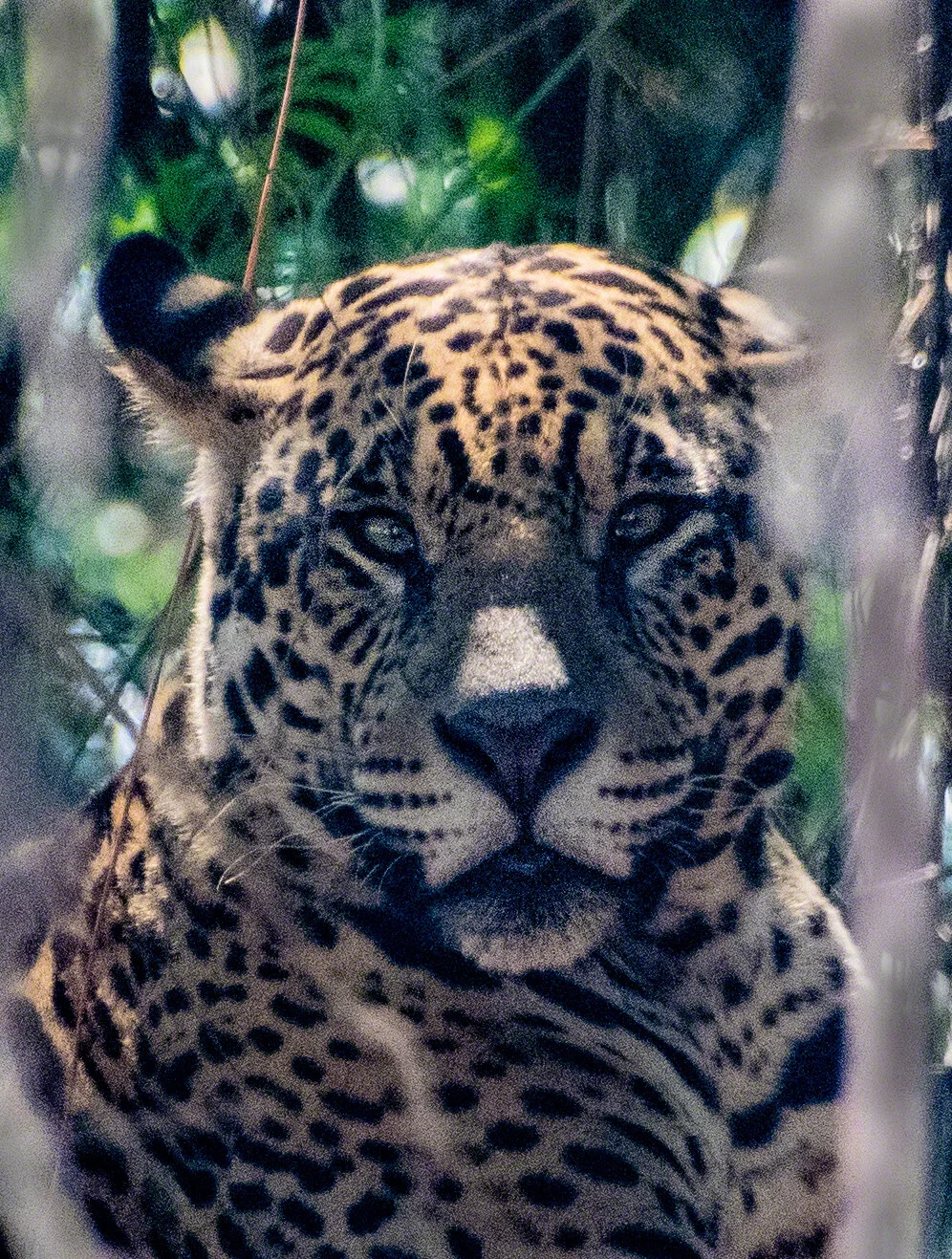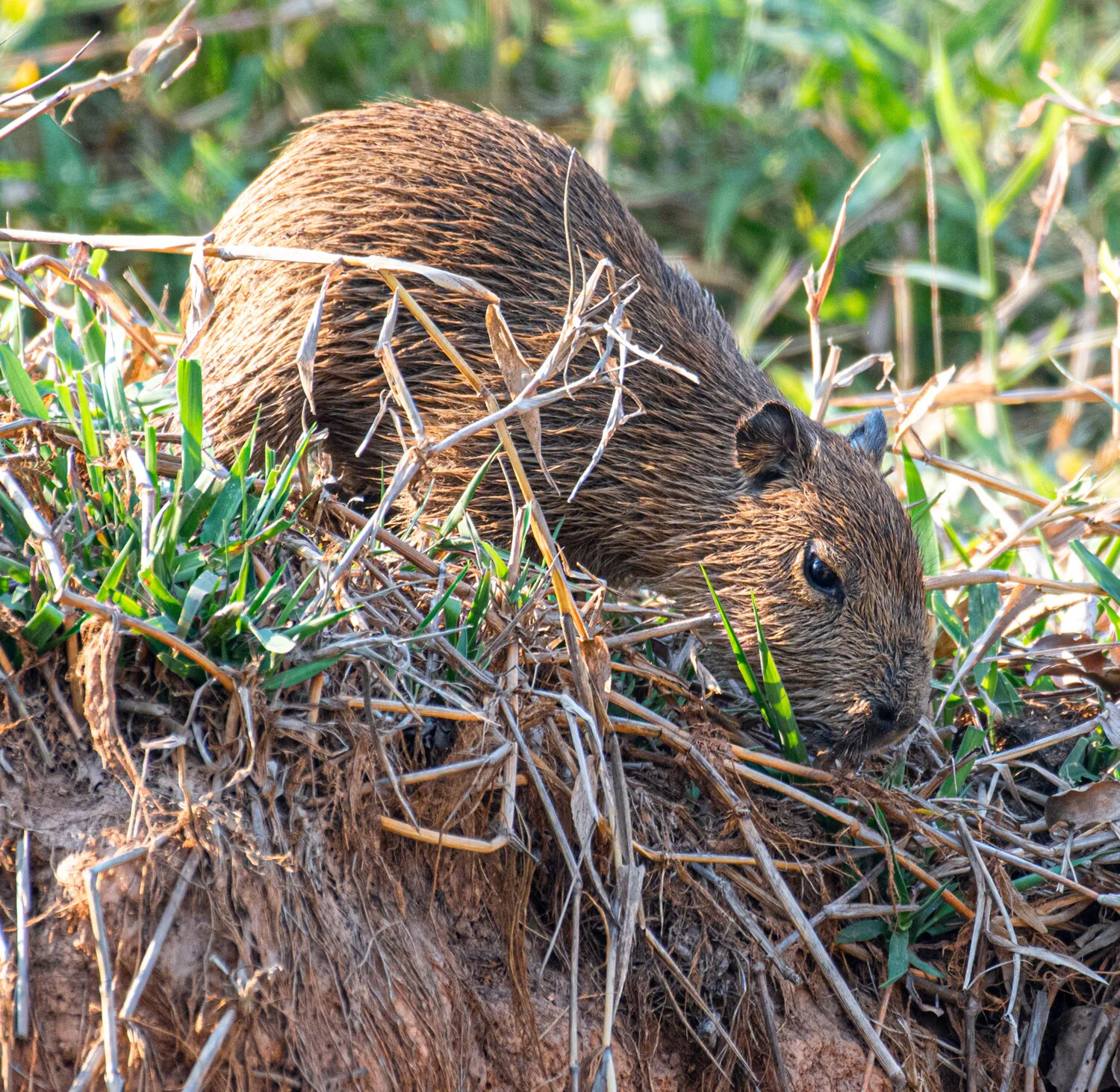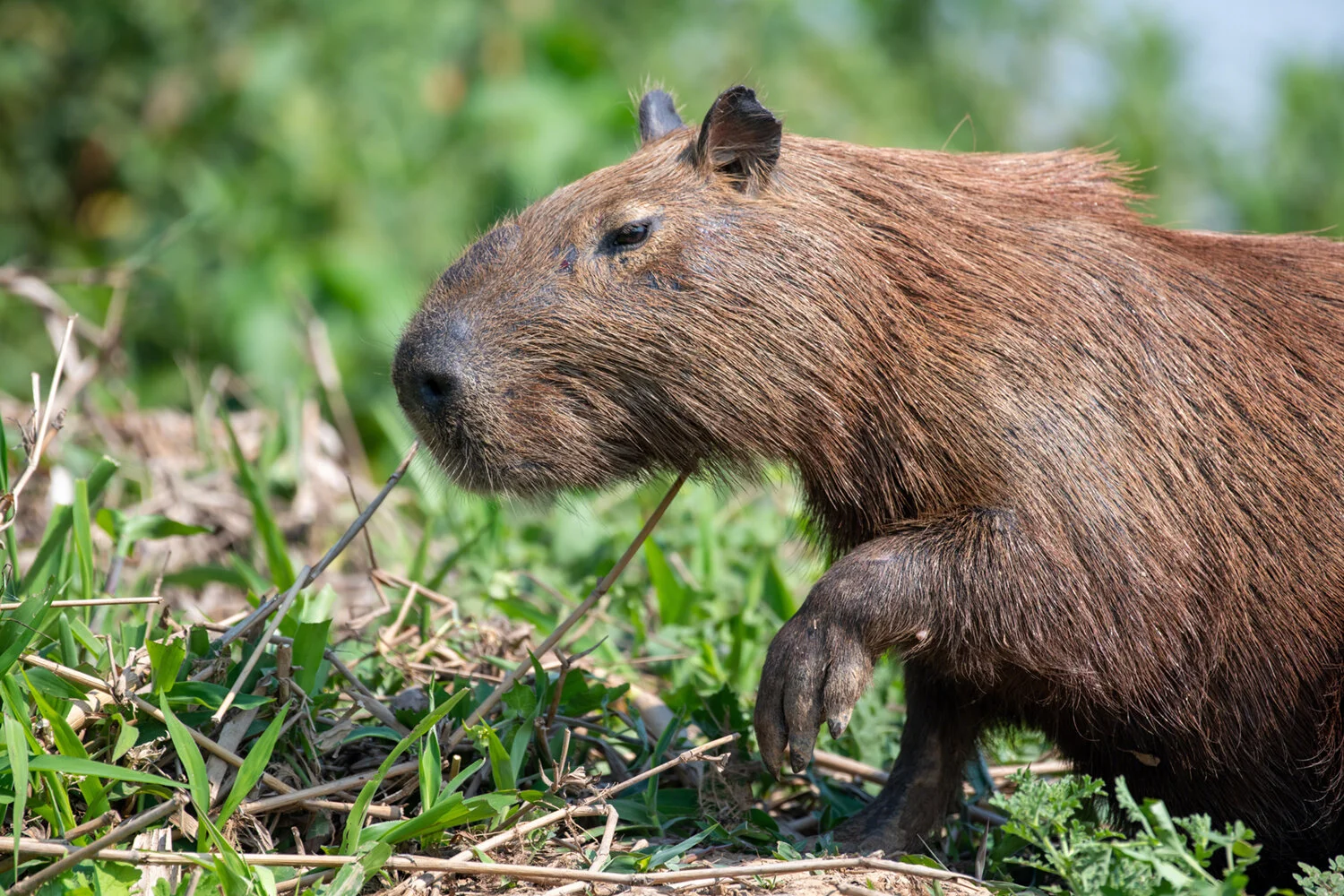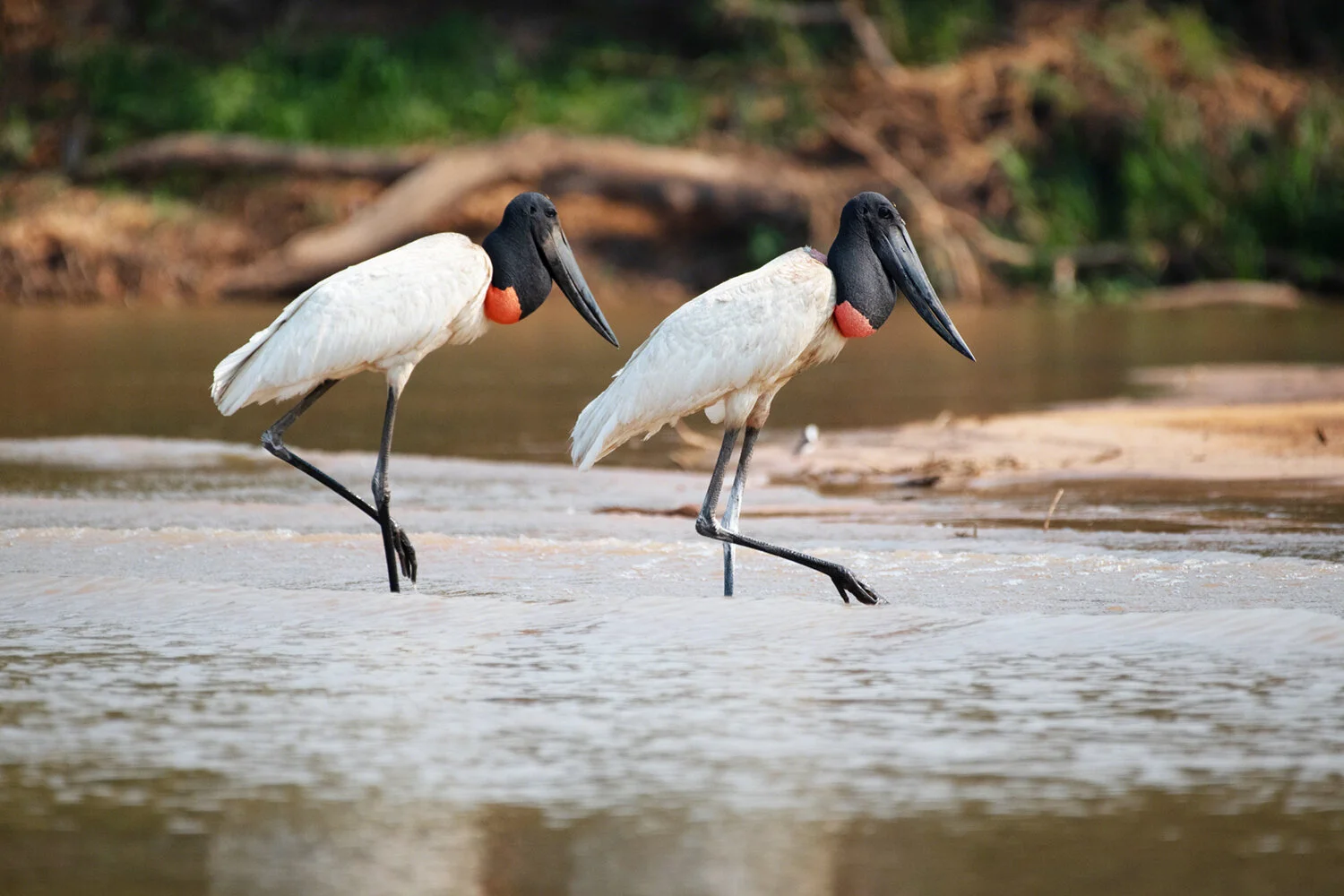Setember 9: Jaguars
Days at Porto Jofre begin early. Breakfast is served at 5:00 a.m., and if you aren’t out on the dock before 5:45 a.m., you are going to miss the opportunity to go out for the morning.
I was up every morning at 4:20 a.m. I didn’t intend to miss a thing—including the stunning sunrise.
Sunrise on the Cuiabá River, Porto Jofre, Brazil
©A Paige Baker, 2019
I’ll be honest—I was steeling myself against the possibility that I wouldn’t see a jaguar at all. After all, there are no guarantees in this life, and I figured my chances of photographing any jaguars at all (and certainly MORE than one jaguar) were inversely proportional to the amount of money I paid to take the tour.
I’m very happy to report that I was mistaken. On our first outing, we saw this beautiful jaguar. Many of the sightings were of the jaguars tucked up securely in the underbrush on the banks of the river. That situation may not always make for the best photos, but seeing these gorgeous creatures was always a reminder of how privileged we were to be there at all.
Sleeping jaguar
©️APaige Baker, 2019
Jaguars are typically solitary creatures. The females generally have 1-2 cubs, who stay with their mother until they are about 2 1/2 years old and then strike out on their own.
The best-loved jaguars are “The Brothers,” Borro and Xando.—and they break all the “rules” about jaguars. The Brothers are 3 1/2, and they still travel, hunt, and sleep together. Whichever one of them is in the lead is always looking back to make sure the other is right behind.
Although they are fully sexually mature, to date The Brothers have shown no sign of separating to mate. Xando is severely cross-eyed, and there is some concern that, because of this, he might not be able to hunt effectively on his own. But no one really knows why they have stayed together or how long their relationship will last. I think a lot of folks are rooting for them to continue their unusual partnership—as Mark said “No male jaguar is going to take on TWO other males.” (As a mom, I can’t help anthropomorphizing and thinking how wonderful it is when siblings take care of each other!)
I worked super hard to get these photos. They are grainy because I had to use a high ISO to shoot into the underbrush. I also practically stood on my head in the boat to shoot them. I didn’t know I was still limber enough to do that!
Borro #1
©️APaige Baker, 2019
Borro #2
©️APaige Baker, 2019
Xando
©️APaige Baker, 2019
The jaguars seem supremely uninterested/unconcerned by humans. Once they are spotted by the boat drivers, they literally can’t do ANYTHING without a crowd, but they don’t seem to mind.
All the drivers are connected via short-wave radio, and when one spots a jaguar, he (and they appear to be ALL “he’s”), radios the others and everyone comes tearing up from wherever they happen to be at the moment. This can take between a few minutes or an hour (!!!) depending on where you are. I asked Paulo why they do that—why not just keep searching for jaguars where you are? He said, “Because you may ride in the boat for 30-45 minutes and then get to watch a jaguar for two hours.” He was right. (As always!)
A few days into this part of the tour, I got concerned about the way my fellow humans (well, me too) were mobbing these cats. There were times when there would be 20 boats all jockeying for position in one spot to catch a glimpse of a jaguar.
I asked Abbie Martin, the biologist who singlehandedly started the Jaguar Identification Project in the Pantanal, if humans were stressing out the cats by following them everywhere, she told me “If they were stressed, they would just go back into the bush.” They ARE cats, after all!
Abbie pointed out that most of the jaguars we saw have been born after the ecotourism began, and they are so used to humans that they don’t really even notice us that much.
After my conversation with her, I decided that they are serious hams who enjoy posing for all the crazy humans who follow them around. It must feel like the days in Egypt when humans worshiped cats as gods….
Posing jaguar
©️APaige Baker, 2019
This poor, sweet girl spent over an hour stalking a capybara—and then it hopped in the river and swam away. You win some, you lose some….
Hunting jaguar
©️APaige Baker, 2019
CAPYBARAS
I can’t image how someone could fail to fall in love with capybaras. They just look as if they are made to cuddle—especially since they rarely move.
They are the world’s largest rodents—but they don’t have a long, naked tail, so I can overlook the rodent part. They really are quite large—the males can reach 130 lbs. when they are full-grown. I’d say those guys are as big as a really large and stocky Rottweiler.
Mostly they sit around like this…. (This formation lets them scan all directions for danger.) When there are a bunch of them and they have littles, they seem to do what elephants do—put the babies in the middle and face out.
Capybara family on the beach
©A Paige Baker, 2019
They seem to be very tender with their littles….
Mama and baby capybaras
©️APaige Baker, 2019
And the littles are quite curious!
Baby capybara
©️APaige Baker, 2019
This photo pains me. This male clearly had an injured (or maybe broken) leg. He was a sitting duck for a jaguar or a caiman to go after him. I know all about the “circle of life,” and I’ve read Hobbes (“Nasty, brutish, and short”), but it still makes me sad to see any animal hurt and in pain… (And yes, before you ask, I eat meat, and I should reevaluate that….but that’s a conversation for another day.)
Injured male capybara
©️APaige Baker, 2019
MORE BEAUTIFUL BIRDS
I never really noticed birds all that much before I went to Australia in 2014. But birds Down Under were so different than ours that I couldn’t help getting interested! And I’ve been fascinated by them ever since…
Rufous-Tailed Jacamar
©️APaige Baker, 2019
Great Black Hawk
©️APaige Baker, 2019
Rufescent Tiger Heron
©️APaige Baker, 2019
And a 5, 6,7, 8! Jabiru storks
©️APaige Baker, 2019
Amazon Kingfisher
©️APaige Baker, 2019
This may be my favorite bird picture ever…..
Black-Capped Donacobius
©️APaige Baker, 2019
And last, but not least….there was this amazing Green Iguana. Every time I see creatures in this family, I am reminded that there are species that can trace their lineage back hundreds of millions of years. The texture of its skin is simply amazing.
Green Iguana
©️APaige Baker, 2019




